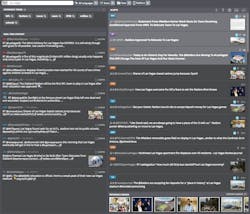Using real-time data for proactive risk mitigation
Leveraging social media feeds has become a prerequisite for almost any Public Safety and law enforcement agency across the United States who seeks to handle crisis in a proactive manner. But using social media feeds like Twitter and other public sources is now becoming part of the risk mitigation planning for others in financial, corporate and critical infrastructure security.
Solution providers like Dataminr have jumped into this space to help those organizations transform real-time data in actionable alerts, providing breaking news and events that could impact them and potential crises that might jeopardize physical and human assets.
Founded in 2009 by three former Yale undergraduate roommates, Dataminr now boasts more than 150 employees and is headquartered in New York City. Dillon Twombly, Vice President and Head of Corporate Risk Sales at Dataminr recently spoke with Security Dealer & Integrator magazine editor-in-chief Paul Rothman about trends in social media.
Paul Rothman: Social media monitoring has been around for a while in the marketing industry (looking for company mentions, etc.)...how has the technology evolved, and how does using social media monitoring for risk management change the traditional dynamic?
Dillon Twombly: Social media monitoring and sentiment analysis continue to be essential tools for marketers, but on a broader scale, security and operations teams are looking to reduce the time between incidents breaking and taking actions to minimize the business impact, protect assets and employees or otherwise address these events.
As social media, especially Twitter, continue to be central channels for breaking news, institutions need to be able to receive and react in real-time to what is published around the world on social media – the new bleeding edge of breaking information.
The technology needs to be simple to use and integrate easily into organizations' legacy systems and processes. Dataminr meets those needs by providing actionable alerts based on the user needs.
Rothman: How does Dataminr’s software work, and what exactly is it “looking for” within social media posts, and how is it communicated to a security operation?
Twombly: Dataminr’s algorithms analyze the full set of publicly available tweets and other public datasets, turning them into actionable alerts that enable security and operations professionals around the world to discover must-know information as events unfold, and then to use the platform to verify those alerts. Alerts are delivered via desktop application, email, mobile applications and other workflow integrated solutions.
Rothman: Is it a standalone system, or how can a security operation integrate the alerts into a VMS or PSIM type of framework?
Twombly: Dataminr works closely with clients to ensure that our critical alerts are seamlessly integrated into existing workflow and processes both across the security team but also with other corporate stakeholders. Through integrations into internal or third-party risk visualization platforms or the use of Dataminr’s proprietary dashboard, email, and mobile application, Dataminr delivers value by allowing teams to be more proactive and take more informed actions across industries within the global Fortune 500.
Rothman: What sets the Dataminr solution apart from competitive offerings from companies such as ZeroFox or Geofeedia?
Twombly: Dataminr’s competitive advantages include access to the full set of publicly available Tweets from Twitter in real-time and a unique ability to surface topic-based content, in the form of incidents, breaking news or other issues impacting clients, across either configurable or pre-specified topic. By proactively surfacing the most relevant content, Dataminr allows major companies to more proactively minimize business disruption and ensure the security and safety of their employees, assets, and brand.
Rothman: What types of security operations are best suited for this type of software, and do you foresee the target market expanding for this sort of software as time goes on?
Twombly: Dataminr has wide application across security and operations teams ranging from situational awareness for security operations and crisis management teams to proactive notification of incidents impacting executive protection and event personnel. Additionally, Dataminr’s Historical Reference Application and Advanced Custom Alerts provide a unique perspective on how events unfolded on social media across a company’s security and risk teams.
Rothman: What can visitors to your ISC West booth expect to see, or what should they ask for from a demo perspective?
Twombly: We encourage ISC West attendees to see the power and impact of Dataminr’s alerts first-hand in a demonstration during ISC West. Based on a company’s risk profile and geographic profile, Dataminr representatives will be able to provide a tailored experience using specific examples where Dataminr has added value and allowed security and operations teams to be more proactive in addressing breaking issues and incidents.
- - - - - - - -
About the Author
Paul Rothman
Editor-in-Chief/Security Business
Paul Rothman is Editor-in-Chief of Security Business magazine. Email him your comments and questions at [email protected]. Access the current issue, full archives and apply for a free subscription at www.securitybusinessmag.com.

